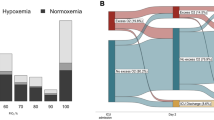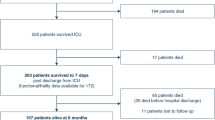Abstract
Goals
To develop and validate a model for probability of hospital mortality for cancer patients at 72 h of intensive care unit (ICU) management.
Patients and methods
This is an inception cohort study performed at four ICUs of academic medical centers in the United States. Defined continuous and categorical variables were collected on consecutive patients with cancer admitted to the ICU. A preliminary model was developed from 827 patients and then validated on an additional 415 patients. Multiple logistic regression modeling was used to develop the models, which were subsequently evaluated for discrimination and calibration. The main outcome measure is in-hospital death.
Results
A probability of mortality model, which incorporates ten discrete categorical variables, was developed and validated. All variables were collected at 72 h of ICU care. Variables included evidence of disease progression, performance status before hospitalization, heart rate >100 beats/min, Glasgow coma score ≤5, mechanical ventilation, arterial oxygen pressure/fractional inspiratory oxygen (PaO2/FiO2) ratio <250, platelets <100 k/µl, serum bicarbonate (HCO3)<20 mEq/l, blood urea nitrogen (BUN) >40 mg/dl, and a urine output of <150 ml for any 8 h in the previous 24 h. The p values for the fit of the preliminary and validation models were 0.535 and 0.354 respectively, and the areas under the receiver operating characteristic (ROC) curves were 0.809 and 0.820.
Conclusions
We report a multivariable logistic regression model to estimate the probability of hospital mortality in critically ill cancer patients at 72 h of ICU care. The model is comprised of ten unambiguous and readily available variables. When used in conjunction with clinical judgment, this model should improve discussions about goals of care of these patients. Additional validation in a community hospital setting is warranted.
Similar content being viewed by others
References
Afessa B, Tefferi A, Hoagland HC, Letendre L, Peters SG (1992) Outcome of recipients of bone marrow transplants who require intensive-care unit support. Mayo Clin Proc 67:117–122
Apolone G, Bertolini G, D'Amico R, Iapichino G, Cattaneo A, De Salvo G et al (1996) The performance of SAPS II in a cohort of patients admitted to 99 Italian ICUs: results from GiViTI. Gruppo Italiano per la Valutazione degli interventi in Terapia Intensiva. Intensive Care Med 22:1368–1378
Ashkenazi YJ, Kramer BS, Harman E (1986) Short-term outcome among patients with leukemia and lymphoma admitted to a medical intensive care unit. South Med J 79:1086–1088
Bach PB, Schrag D, Nierman DM, Horak D, White P Jr, Young JW et al (2001) Identification of poor prognostic features among patients requiring mechanical ventilation after hematopoietic stem cell transplantation. Blood 98:3234–3240
Bastos PG, Sun X, Wagner DP, Knaus WA, Zimmerman JE (1996) Application of the APACHE III prognostic system in Brazilian intensive care units: a prospective multicenter study. Intensive Care Med 22:564–570
Brivet FG, Kleinknecht DJ, Loirat P, Landais PJ (1996) Acute renal failure in intensive care units--causes, outcome, and prognostic factors of hospital mortality: a prospective, multicenter study. French Study Group on Acute Renal Failure. Crit Care Med 24:192–198
Brunet F, Lanore JJ, Dhainaut JF, Dreyfus F, Vaxelaire JF, Nouira S et al (1990) Is intensive care justified for patients with haematological malignancies? Intensive Care Med16:291–297
Carson SS, Bach PB (2001) Predicting mortality in patients suffering from prolonged critical illness: an assessment of four severity-of-illness measures. Chest 120:928–933
Chen CH, George SL (1985) The bootstrap and identification of prognostic factors via Cox's proportional hazards regression model. Stat Med 4:39–46
Chertow GM, Christiansen CL, Cleary PD, Munro C, Lazarus JM (1995) Prognostic stratification in critically ill patients with acute renal failure requiring dialysis. Arch Intern Med 155:1505–1511
Consensus statement of the Society of Critical Care Medicine's Ethics Committee regarding futile and other possibly inadvisable treatments (1997) Crit Care Med 25:887–891
Cox SC, Norwood SH, Duncan CA (1985) Acute respiratory failure: mortality associated with underlying disease. Crit Care Med 13:1005–1008
Crawford SW, Petersen FB (1992) Long-term survival from respiratory failure after marrow transplantation for malignancy. Am Rev Respir Dis 145:510–514
Crawford SW, Schwartz DA, Petersen FB, Clark JG (1988) Mechanical ventilation after marrow transplantation. Risk factors and clinical outcome. Am Rev Respir Dis 137:682–687
Denardo SJ, Oye RK, Bellamy PE (1989) Efficacy of intensive care for bone marrow transplant patients with respiratory failure. Crit Care Med 17:4–6
Estopa R, Torres MA, Kastanos N, Rives A, Agusti-Vidal A, Rozman C (1984) Acute respiratory failure in severe hematologic disorders. Crit Care Med 12:26–28
Ewer MS, Ali MK, Atta MS, Morice RC, Balakrishnan PV (1986) Outcome of lung cancer patients requiring mechanical ventilation for pulmonary failure. JAMA 256:3364–3366
Groeger JS, Aurora RN (2001) Intensive care, mechanical ventilation, dialysis, and cardiopulmonary resuscitation. Implications for the patient with cancer. Crit Care Clin 17:791–803
Groeger JS, Lemeshow S, Price K, Nierman DM, White P Jr, Klar J et al (1998) Multicenter outcome study of cancer patients admitted to the intensive care unit: a probability of mortality model. J Clin Oncol 16:761–770
Groeger JS, White P Jr, Nierman DM, Glassman J, Shi W, Horak D et al (1999) Outcome for cancer patients requiring mechanical ventilation. J Clin Oncol 17:991–997
Guiguet M, Blot F, Escudier B, Antoun S, Leclercq B, Nitenberg G (1998) Severity-of-illness scores for neutropenic cancer patients in an intensive care unit: Which is the best predictor? Do multiple assessment times improve the predictive value? Crit Care Med 26:488–493
Hanley JA, McNeil BJ (1982) The meaning and use of the area under a receiver operating characteristic (ROC) curve. Radiology 143:29–36
Harrell FE Jr, Lee KL, Mark DB (1996) Multivariable prognostic models: issues in developing models, evaluating assumptions and adequacy, and measuring and reducing errors. Stat Med15:361–387
Hosmer DW, Lemeshow S (1989) Applied logistic regression. Wiley: New York
Jackson T, McKeag N, Stuart J (1997) Care after bone marrow transplantation. Nurs Times 93:48–49
Kapoor M, Chan GZ (2001) Malignancy and renal disease. Crit Care Clin 17:571–598
Klastersky J, Paesmans M, Rubenstein EB, Boyer M, Elting L, Feld R et al (2000) The Multinational Association for Supportive Care in Cancer risk index: A multinational scoring system for identifying low-risk febrile neutropenic cancer patients. J Clin Oncol18:3038–3051
Knaus WA, Draper EA, Wagner DP, Zimmerman JE (1985) Apache II: a severity of disease classification system. Crit Care Med 13:818–829
Le Gall J-R, Lemeshow S, Sauinier F (1993) A new Simplified Acute Physiology Score (SAPS II) based on a European/North American Multicenter Study. JAMA 270:2957–2963
Lemeshow S, Teres D, Klar J, Avrunin JS, Gehlbach SH, Rapoport J (1993) Mortality Probability Models (MPM II) based on an international cohort of intensive care unit patients. JAMA 270:2478–2486
Lemeshow S, Klar J, Teres D, Avrunin JS, Gehlbach SH, Rapoport J et al (1994) Mortality probability models for patients in the intensive care unit for 48 or 72 hours: a prospective, multicenter study. Crit Care Med 22:1351–1358
Marcin JP, Pollack MM, Patel KM, Ruttimann UE (2000) Combining physician's subjective and physiology-based objective mortality risk predictions. Crit Care Med 28:2984–2990
Mazumdar M, Glassman JR (2000) Categorizing a prognostic variable: review of methods, code for easy implementation and applications to decision making about cancer treatments. Stat Med 19:113–132
Moreno R, Miranda DR, Fidler V, Van Schilfgaarde R (1998) Evaluation of two outcome prediction models on an independent database. Crit Care Med 26:50–61
Motzer RJ, Mazumdar M, Bacik J, Berg W, Amsterdam A, Ferrara J (1999) Survival and prognostic stratification of 670 patients with advanced renal cell carcinoma. J Clin Oncol 17:2530–2540
Murphy-Filkins R, Teres D, Lemeshow S, Hosmer DW (1996) Effect of changing patient mix on the performance of an intensive care unit severity-of-illness model: how to distinguish a general from a specialty intensive care unit. Crit Care Med 24:1968–1973
Nouira S, Belghith M, Elatrous S, Jaafoura M, Ellouzi M, Boujdaria R et al (1998) Predictive value of severity scoring systems: comparison of four models in Tunisian adult intensive care units. Crit Care Med 26:852–859
Paesmans M, Sculier JP, Libert P, Bureau G, Dabouis G, Thiriaux J et al (1995) Prognostic factors for survival in advanced non-small-cell lung cancer: univariate and multivariate analyses including recursive partitioning and amalgamation algorithms in 1,052 patients. The European Lung Cancer Working Party. J Clin Oncol 13:1221–1230
Paesmans M, Sculier JP, Lecomte J, Thiriaux J, Libert P, Sergysels R et al (2000) Prognostic factors for patients with small cell lung carcinoma: analysis of a series of 763 patients included in 4 consecutive prospective trials with a minimum follow-up of 5 years. Cancer 89:523–533
Paz HL, Crilley P, Weinar M, Brodsky I (1993) Outcome of patients requiring medical ICU admission following bone marrow transplantation. Chest 104:527–531
Paz HL, Garland A, Weinar M, Crilley P, Brodsky I (1998) Effect of clinical outcomes data on intensive care unit utilization by bone marrow transplant patients. Crit Care Med 26:66–70
Peters SG, Meadows III JA, Gracey DR (1988) Outcome of respiratory failure in hematologic malignancy. Chest 94:99–99
Price KJ, Thall PF, Kish SK, Shannon VR, Andersson BS (1998) Prognostic indicators for blood and marrow transplant patients admitted to an intensive care unit. Am J Respir Crit Care Med 158:876–884
Rubenfeld GD, Crawford SW (1996) Withdrawing life support from mechanically ventilated recipients of bone marrow transplants: a case for evidence-based guidelines. Ann Intern Med 125:625–633
Sauerbrei W, Schumacher M (1992) A bootstrap resampling procedure for model building: application to the Cox regression model. Stat Med 11:2093–2109
Schapira DV, Studnicki J, Bradham DD, Wolff P, Jarrett A (1993) Intensive care, survival, and expense of treating critically ill cancer patients. JAMA 269:783–786
Schuster DP, Marion JM (1983) Precedents for meaningful recovery during treatment in a medical intensive care unit. Outcome in patients with hematologic malignancy. Am J Med 75:402–408
Sculier JP, Markiewicz E (1993) Cardiopulmonary resuscitation in medical cancer patients: the experience of a medical intensive-care unit of a cancer centre. Support Care Cancer 1:135–138
Sculier JP, Paesmans M, Markiewicz E, Berghmans T (2000) Scoring systems in cancer patients admitted for an acute complication in a medical intensive care unit. Crit Care Med 28:2786–2792
Shusterman N, Strom BL, Murray TG, Morrison G, West SL, Maislin G (1987) Risk factors and outcome of hospital-acquired acute renal failure. Clinical epidemiologic study. Am J Med 83:65–71
Sirio CA, Tajimi K, Tase C, Knaus WA, Wagner DP, Hirasawa H et al (1992) An initial comparison of intensive care in Japan and the United States. Crit Care Med 20:1207–1215
Spiegel DM, Ullian ME, Zerbe GO, Berl T (1991) Determinants of survival and recovery in acute renal failure patients dialyzed in intensive-care units. Am J Nephrol 11:44–47
Staudinger T, Stoiser B, Mullner M, Locker GJ, Laczika K, Knapp S et al (2000) Outcome and prognostic factors in critically ill cancer patients admitted to the intensive care unit. Crit Care Med 28:1322–1328
Todd K, Wiley F, Landaw E, Gajewski J, Bellamy PE, Harrison RE et al (1994) Survival outcome among 54 intubated pediatric bone marrow transplant patients. Crit Care Med 22:171–176
Welch HG, Larson EB (1989) Cost effectiveness of bone marrow transplantation in acute nonlymphocytic leukemia. NEJM 321:807–812
Zhu BP, Lemeshow S, Hosmer DW, Klar J, Avrunin J, Teres D (1996) Factors affecting the performance of the models in the Mortality Probability Model II system and strategies of customization: a simulation study. Crit Care Med 24:57–63
Acknowledgment
We are indebted to Peter B. Bach for his review and assistance with this manuscript.
Author information
Authors and Affiliations
Corresponding author
Additional information
Funding for initiation and coordination of this project was provided by Memorial Sloan Kettering Cancer Center. Participating institutions providing resources for site-specific data collection. This paper was presented in part at the annual meeting of the American Society of Clinical Oncology in May, 2001 held in San Francisco, CA, USA
Rights and permissions
About this article
Cite this article
Groeger, J.S., Glassman, J., Nierman, D.M. et al. Probability of mortality of critically ill cancer patients at 72 h of intensive care unit (ICU) management. Support Care Cancer 11, 686–695 (2003). https://doi.org/10.1007/s00520-003-0498-9
Received:
Accepted:
Published:
Issue Date:
DOI: https://doi.org/10.1007/s00520-003-0498-9




